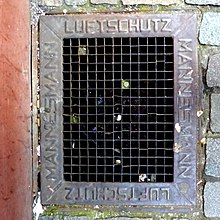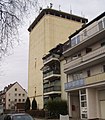air-raid shelter
An air raid shelter is a structure designed to protect against air attacks . The air raid shelter is to be separated from the air raid shelter or air raid shelter, which serves the same purpose but is structurally integrated into a building that is not primarily used for air protection .
history
Second World War
development

In preparation for the Second World War , air raid shelters were built in Germany from the 1930s. From 1940 onwards, under the direction of Hermann Göring, as Commander-in-Chief of the Air Force, this took place in large numbers in all large German cities that were classified as first-order air raids. The bunkers were intended to protect the civilian population. In 1941/42 most of the bunkers were completed and saved many lives during air raids.
Since the air raid bunkers were built with concrete walls several meters thick to withstand the bombs, in many cases it was too costly to clear them up after the Second World War. They are therefore preserved in large numbers in many of the major cities of the former Greater German Reich . Some of them were kept as air raid bunkers during the Cold War , some were used for civilian use, but some are also empty because conversion is difficult due to the structural conditions. Today some of them are under monument protection .
Designs
A distinction is made between underground systems (deep bunkers) and above-ground systems ( high bunkers ). The floor plans can be designed differently. High bunkers were often given a roof that was not structurally necessary for camouflage, so that from the air they appeared like residential buildings. Sometimes this was also planned , for example with the high-rise bunker in the city center of Trier , in order to better integrate the bunker buildings optically into the cityscape, for the same reason plastering and painting of the exterior surfaces were also carried out.
Air raid shelters are mainly made of reinforced concrete. For this purpose, the lattice reinforcement , especially the spiral reinforcement from DYWIDAG and the Braunschweig reinforcement, was used in the early days of the Second World War . Wall and ceiling thicknesses are up to 3.50 m. The entrances are additionally protected by concrete shields, so-called splinter protection walls.
In contrast to the facilities after 1960, air raid shelters from World War II were mostly divided into small areas and had toilet facilities with flushing water (today, dry toilets are kept). In side rooms there are mostly kitchens, storage rooms, medical treatment rooms, coffin stores and the like. In order to prevent a possible attack with poisonous gas , the air raid shelters had a gas lock with two doors, of which only one could be opened in the event of a gas alarm. In areas at risk of fire, the fresh air that was sucked in was led through a sand filter (the filter was operated using electric fans or hand crank fans) in order to lower the temperature of hot smoke gases. The penetration of gas into the shelter was prevented by a slight overpressure in the shelter.
Labelling
During the Second World War, references to air raid shelters for civilians were placed in the public space of the Greater German Reich . The notice LSR (air raid shelter) was affixed to the outer walls of corresponding buildings in white fluorescent paint (due to blackout or power failure) , often connected with an arrow, also white. This arrow indicated the entrance. Emergency exits were marked with arrows or with the letters NA , references to nearby hydrants with an "H" . Ventilation shafts and bunker emergency exits were often covered by steel grilles. If they are still available, they can be easily recognized by the label Mannesmann- Luftschutz .
Corresponding markings are also used in other countries, e.g. B. in Great Britain , Spain , France , USA or Italy .
Cold War
From the mid-1960s to 1978, bunkers and tunnel systems from the Second World War were restored as shelters for civil protection in the Federal Republic of Germany , and new systems were built. Air conditioning and cooling well systems were installed to enable a higher occupancy density. Since 1978 this technology has been increasingly replaced by the utilization program: only simple ventilation with complete filter technology was installed, no air conditioning. From the mid-1990s, no more plants were built due to the global relaxation. Existing civil defense systems are partly preserved, partly they have been abandoned.
Individual bunkers
- Former underground bunker Alexanderplatz in Berlin-Mitte , one of the largest bunkers, for 3,500 people
- Spruce bunker in Berlin-Kreuzberg . In May 1945, around 30,000 people found shelter in the converted gasometer .
- Pallasstrasse bunker in Berlin-Schöneberg . The largest civil defense facility in Berlin with 4,809 shelter sites.
- Reichsbahnbunker-Friedrichstrasse in Berlin-Mitte
- Air raid shelter in Bochum and Wattenscheid
- Bunker in Braunschweig
- Valentin submarine bunker near Bremen
- Bunker in Emden
- Hamburg flak towers
- Steintorwall underground bunker in Hamburg
- Bunker in Hamburg
- High bunker in Lazarettstrasse Münster
- High bunker on the Pragsattel in Stuttgart
- Trier high bunker
- Viennese flak towers
- Air raid shelters in Wuppertal
- Bunker Church Saint Sacrament (Düsseldorf)
gallery
Flak bunker in Hamburg-Wilhelmsburg
A bunker with camouflage paint in the Wattenscheid district of Bochum
Bunker in Berlin as a museum of contemporary art. On the roof is the replica of the Barcelona Pavilion .
High bunker designed by Leo Winkel in Darmstadt
High bunker at the confluence of the Laubenweg in the Kronacher Straße in Fürth from the 1930s with a capacity of 900 shelter places.
The Nuremberg Garrison Museum is located in the high bunker Hohe Marter in Nuremberg-Schweinau (1941) .
Flanders bunker in Kiel-Wik
Iltis bunker in Kiel- Gaarden with a work of art for the sailors' uprising in 1918 Shahin Charmi
literature
- High Command of the Wehrmacht (Ed.): Regulation L.Dv. 793 - Structural air defense. Planning and implementation of structural measures for public air raid shelters. 1939.
- Henning Angerer: Flak bunker. Concrete story. Results Verlag, Hamburg 2000, ISBN 3-87916-057-0 , p. 135.
- Ulrich Alexis Christiansen: Hamburg's dark worlds. The mysterious underground of the Hanseatic city. Ch.links, Berlin 2008, ISBN 978-3-86153-473-0 , various pages.
- Jürgen Engel: Bunker as Xenosoma. Conflicts in the adaptation of air raid shelters . In: Christian Hoffstadt , Franz Peschke, Andreas Schulz-Buchta, Michael Nagenborg (eds.): The foreign body. Projekt Verlag, Bochum / Freiburg 2008, ISBN 978-3-89733-189-1 , pp. 571-586 ( Aspects of Medical Philosophy 6).
- Michael Foedrowitz : Bunker Worlds. Air raid systems in northern Germany. Ch. Links, Berlin 1998, ISBN 3-86153-155-0 , p. 221.
- Andreas O'Brien, Holger Raddatz: The bunkered city. Air raid systems in Osnabrück and the surrounding area. Books on Demand, Norderstedt 2009, ISBN 978-3-8370-7545-8 .
- Helga Schmal, Tobias Selke: Bunker - air protection and air defense construction in Hamburg. Christians, Hamburg 2001, ISBN 3-7672-1385-0 , p. 141 ( cultural authority, monument protection office. Topic series 7).
- Robert Schwienbacher: LSR - Air raid relics of the Second World War in the Cologne city area , Cologne 2014, ISBN 978-3-9818619-3-8
- Doris Tillmann; Johannes Rosenplänter: Air War and "Home Front". War experience in the Nazi society in Kiel 1929-1945 . Solivagus-Verlag, Kiel 2020, ISBN 978-3-947064-09-0 .
- Markus Titsch: Bunker in Wilhelmshaven. Brune Mettcker, Wilhelmshaven 2005, ISBN 3-930510-29-4 , p. 223.
- Rolf Zielfleisch: Stuttgart Bunker Worlds. typoform, Stuttgart 2006, ISBN 3-939502-08-1 , p. 144.
- Haubrock, O'Brien: The air raid shelter on the Kalkhügel - a former air raid shelter in Osnabrück. ISBN 978-3-8448-1154-4
- Inge Marßolek ; Marc Buggeln (Ed.): Bunker. War site, refuge, memory space. Campus Verlag: Frankfurt am Main 2008, ISBN 978-3-593-38603-4 .
- Melanie Mertens: Uncomfortable Colossi. High bunker in Mannheim. In: Monument Preservation in Baden-Württemberg , Volume 40, 2011, Issue 1, pp. 9–15 ( PDF )
Web links
- Luftschutz-Bunker.de (IGEL) ( Memento from January 27, 2003 in the Internet Archive )
- Virtual tour through a ring stair tower bunker in Hamburg at hamburgerunterwelten.de
- Civil defense systems database on geschichtsspuren.de
- Information page on Vergessene-Geschichte.de
- Documentation of bunker systems in Osnabrück on untergrundosnabrueck.de
Individual evidence
- ↑ Mysterious signs - air raid protection in Fürth during World War II on renate-trautwein.de
- ↑ Information on the underground bunker under Alexanderplatz on berliner-unterwelten.de












